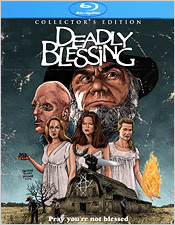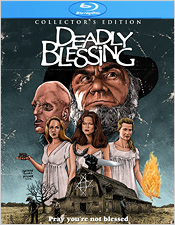Deadly Blessing: Collector's Edition (Blu-ray Review)

Director
Wes CravenRelease Date(s)
1981 (January 22, 2013)Studio(s)
Universal (Shout!/Scream Factory)- Film/Program Grade: B-
- Video Grade: B
- Audio Grade: B-
- Extras Grade: A
Review
Before Wes Craven became synonymous with a certain burned-up, fedora-wearing, razor-fingered horror villain, he made a string of low budget horror films, many of which fell into obscurity shortly thereafter. Deadly Blessing happens to be one of those films and the film is now making its debut on Blu-ray for the first time, giving us a glimpse at one of Craven’s early works post The Hills Have Eyes and The Last House on the Left.
Once you’ve seen Deadly Blessing, it’s immediate why it fell between the cinematic cracks and never really got seen by anybody. On the one hand you’ve got overbearing religious fanaticism looming heavily over everything in the film. On the other, you’ve got a horror element that doesn’t make a whole lot of sense as to exactly why it’s actually happening. Could it be that the leader of the Amish community (or Hittites as they’re called in the film) is going to extreme lengths to stamp out evil in his neck of the woods, or is it something else? The film plays out like a mystery, but not many red herrings are thrown out there to give the audience a chance to point fingers at different suspects. It more or less plays up the cult aspects and attempts to drive home that it’s a member of the Amish community doing the killing. So much so that when the plot is finally revealed, you might find yourself asking “Huh, where did that come from?” In your mind you begin to re-evaluate it all and it apparently just comes out of left field with no real build up to it. If you go back and re-watch the film, you can see the elements in place, but they don’t get played up enough for it to be noticeable. I apologize for my vagueness here, but it’s difficult to talk about the plot of this film without spoiling it, and that wouldn’t be fair to an obscure film, now would it?
The film isn’t a total loss though. Wes Craven doesn’t always make the greatest films, but he does make interesting ones, and that’s how I’d like to think of Deadly Blessing. I mentioned the religious fanaticism previously, and the scenes that involving that are probably the best in the whole film. Seeing how deeply rooted these people are in their conviction vs. everyone around them is really the whole appeal of this film for me. The horror plot is serviceable enough on its own I suppose, but it’s not the real star of the show. Where else are you going to see Ernest Borgnine in an fake Amish beard? Craven even managed to replicate himself later on in his career using ideas from this film. For instance, nearly all of the shots in the infamous bathtub scene are identical to the ones used later in A Nightmare on Elm Street. You might even recognize a young and well-photographed Sharon Stone, or notice an early musical score by James Horner. So the film isn’t without merit, but it’s not likely to blow you away. It’s a curiosity for sure, since it’s been buried in obscurity for so long, but thanks to the good folks at Scream Factory, it no longer is.
The transfer of the film probably won’t knock most videophiles’ socks off either. I give credit more to the locations they shot on than the actual transfer because detail is very evident, especially in daylight. Skin tones are consistent and colors are mostly vibrant (blues, reds and greens are probably the strongest). Film grain prevents blacks from being as deep as they could be, while the grain structure is mostly intact. It’s not overly grainy, but being low budget, there’s plenty of it to go around. Yet it’s also not the grainiest low budget feature I’ve seen either. It’s definitely been cleaned up and there appears to be some haloing in some of the outdoor shots when natural light has been used. The frame itself is very stable, but there’s some minor print flaws left behind in the image (scratches, dirt, etc). Overall, most people should find it a more than satisfactory presentation, as it is a terrific-looking film. It probably isn’t the best that the film could look, but given the circumstances, and especially it not being on a digital format before (at least not in the US), I’d say that this is as good as it’s likely to ever look, which is pretty good.
On the audio side of things, you get two options: DTS-HD 5.1 and 2.0. Purists will want to go with the original soundtrack, but if you’re looking for a great surround sound presentation, then you’re likely to be disappointed. It’s definitely a front and center heavy mix (unsurprisingly). There’s barely any ambience in the rear speakers, nor are there many bass-heavy moments. This film seemingly wasn’t designed to be all that sound-reliant so it doesn’t translate well into a 5.1 soundtrack. The only way it could is if it were re-engineered from scratch. You’re better off just sticking with the original 2.0 theatrical soundtrack in this case, which in my opinion, is how it should be viewed anyway. There are also subtitles in English for those who might need them.
Extras include an audio commentary by Wes Craven (moderated by Horror’s Hallowed Grounds alumnus Sean Clark); Say Your Prayers!, an interview with actor Michael Berryman; Secrets Revealed, an interview with actress Susan Buckner; Rise of the Incubus, an interview with creature designer John Naulin; So it Was Written, dual interviews with writers Glenn Benest and Matthew Barr about the film’s screenplay; the theatrical trailer; TV spots, radio spots; and finally a photo gallery. It’s definitely a great little set of extras, especially the commentary. There are some tidbits of information in there that are both informative and provocative. It also helps that Wes Craven (along with Martin Scorsese, Joe Dante and John Landis) is one of those directors who speaks so well when he’s commenting that I could listen to him reading his grocery list and be enthralled. Well, maybe not, but you get the idea.
Overall, I’m quite happy that Deadly Blessing is now among us. This is a great release from Scream Factory, as per usual, and if you’re a horror fan, it goes without saying that you should run out and pick it up. Horror film historians will probably be interested in its relevance as well. Either way, do check it out.
- Tim Salmons

